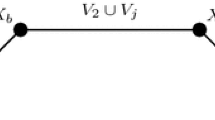Abstract
By the augmentation axiom of matroids, given two independent sets whose cardinalities are not equal, there exists some other independent set of which the independent set with smaller cardinality is a proper subset. The augmentation axiom requires only the existence of independent set augmentation, not its uniqueness. This causes that the collections of bases of some matroids can be reduced while the unions of the collections of bases of these matroids remain unchanged. We may say these matroids are not minimal. This paper studies a type of matroids whose augmentations of independent sets have some degree of uniqueness and whose collections of bases are minimal in a sense. First, we propose the concept of secondary basis unique augmentation matroid, and prove a matroid is a secondary basis unique augmentation matroid iff the collection of the circuits of its dual matroid is a partition. Then we propose the concept of union minimal matroid based on rank-preserving weak-map, and prove that secondary basis unique augmentation matroids are union minimal matroids. Finally, we propose the concept of basis unique exchange matroid and study its properties.
Similar content being viewed by others
References
Edmonds J (1971) Matroids and the greedy algorithm. Mathem Prog 1:127–136
Lai H (2001) Matroid theory. Higher Education Press, Beijing
Lawler E (2001) Combinatorial optimization: networks and matroids. Dover Publications
Li Q, Zhu W (2013) Closed-set lattice of regular sets based on a serial and transitive relation through matroids. Intern J Mach Learn Cybernet doi:10.1007/s13042-013-0176-2
Liu G, Chen Q (1994) Matroid. National University of Defence Technology Press, Changsha
Liu Y, Zhu W, Zhang Y (2012) Relationship between partition matroid and rough set through k-rank matroid. J Info Comput Sci 8:2151-2163
Liu Y, Zhu W (2013) Parametric matroid of rough set to appear in International Journal of Uncertainty, Fuzziness and Knowledge-Based Systems
Mayhew D (2005) Families of matroids induced by classes of graphs. Adv Appl Math 34:616–633
Oxley J (2011) Matroid Theory, second edition. Oxford University Press, New York
Oxley J, Whittle G (1998) On weak maps of ternary matroids. Europ J Combinat 19: 377–389
Tang J, She K, Zhu W (2012) Matroidal structure of rough sets from the viewpoint of graph theory. J Appl Math 2012: 1–27
Wang S, Zhu Q, Zhu W, Min F (2012) Matroidal structure of rough sets and its characterization to attribute reduction. Knowl Based Syst 35:155–161
Welsh DJA (2010) Matroid theory. Dover Publications, New York
Whitney H (1935) On the abstract properties of linear dependence. Amer J Math 57:509–533
Zhu W, Wang S (2011) Matroidal approaches to generalized rough sets based on relations. Intern J Mach Learn Cybernet 2:273-279
Acknowledgments
This work is in part supported by the National Science Foundation of China under Grant Nos. 61170128, 61379049 and 61379089, the Natural Science Foundation of Fujian Province, China under Grant No. 2012J01294, the Fujian Province Foundation of Higher Education under Grant No. JK2012028, and the Postgraduate Education Innovation Base for Computer Application Technology, Signal and Information Processing of Fujian Province (No. [2008]114, High Education of Fujian).
Author information
Authors and Affiliations
Corresponding author
Rights and permissions
About this article
Cite this article
Yao, H., Zhu, W. & Wang, FY. Secondary basis unique augmentation matroids and union minimal matroids. Int. J. Mach. Learn. & Cyber. 5, 955–962 (2014). https://doi.org/10.1007/s13042-014-0237-1
Received:
Accepted:
Published:
Issue Date:
DOI: https://doi.org/10.1007/s13042-014-0237-1




